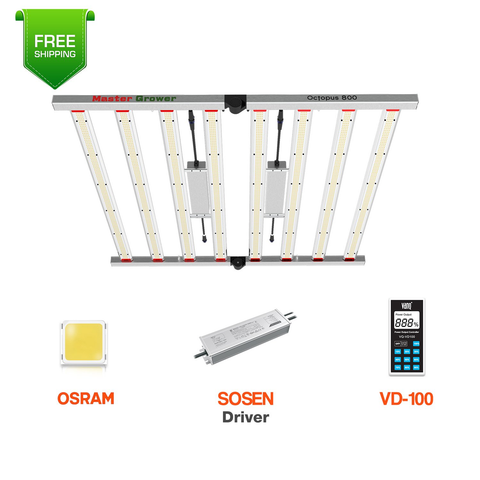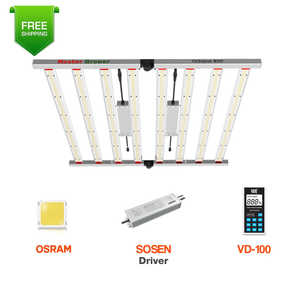All About Seedling Lighting
A good harvest of garden crops in most regions can only be possible by horticulture LED grow lights. Seeds sow in early spring, when the daylight hours are still short and the sun's rays are clearly not enough. And the growing season of plants requires an active course of photosynthesis, which requires light energy for 10-12 hours during the day.

What is horticulture LED grow lights?
It is obvious that the short-term spring sun does not provide the proper conditions for the development of the planted seedlings. Artificial lighting for seedlings at home using horticulture LED grow lights is the best solution.
However, not every luminaire can produce a tangible effect. Similarly, it requires providing light radiation in a certain spectrum, favorable for plant growth.
If we compare the seedlings that simply display on the windowsill and seedlings with high-quality lighting, then even a layman will notice the differences. Furthermore, plants that do not receive the right amount of light look frail and thin.
TRY OCTOPUS 800 800W FULL SPECTRUM LED GROW LIGHT
Their color is pale green, and the underside of the leaves is already slightly yellow. There is a clear hunger for light.
Our Lights are Ideal for Smooth Growing
Conversely, seedlings that grow under favorable additional lighting delight the eye with luscious green foliage. Thick and resilient stems not only stretch up, but also expand in breadth, giving new shoots. Such seedlings, planted in the garden, will give a bountiful harvest and will delight the zealous summer resident.
The need for extra light: Try OCTOPUS 800
Additional lighting for seedlings is a critical factor in growing viable plants. Nutrient soil and systematic watering are insufficient for development, since the main source of energy for plants is light.
Light energy absorbs by chlorophyll (a special pigment) common in the leaves. Similarly, it supports photosynthesis, a process that provides seedlings with nutrients (hydrocarbons). The starting materials for the photochemical reaction are carbon dioxide and water, and the by-product is oxygen.
Thus, by combining natural and horticulture LED grow lights, the seedlings receive a balanced nutrition that promotes intensive growth of both the aerial part and the root system.
Influence of different spectra on seedlings
Red
Generally, it contributes the largest contribution to the energy required for the intensive course of photosynthesis. Accelerates seed germination, normalizes seedling development and improves their immunity. Hence, it increases the volume of biomass.
Blue and purple
They are regulators of the rate of development. Similarly, it allows to slow down the stretching of sprouts upward and to obtain better lateral growth of stems, due to the growth of cell mass. Moreover, The resulting seedlings distinguish by short, but denser and thickened stems, fleshy leavest
Yellow and green
They serve as a kind of balance, restraining the excessive impact of other active colors of the useful spectrum.
Types of horticulture LED grow lights for seedlings
Fluorescent lamps
These light sources, including their more modern version, energy-saving lamps, create only a white glow. Moreover, horticulture LED grow lights do not include the most useful spectral components. In addition, the rather rapid degradation of light emitters causes a decrease in the intensity of the luminous flux.
Sodium lamps
Sodium gas discharge light sources emit in the orange-red wavelength range. They are mainly common in greenhouses. They are rarely chosen for home use due to high power consumption, sensitivity to voltage surges and poor environmental friendliness.
LED phytolamps
Generally, phytolamps based on light-emitting diodes are the most popular means for illuminating seedlings. The secret of their effectiveness lies in the emission of light with peak intensity in the "phytoactive" spectrum (from 450 to 660 nanometers), Similarly, it is most favorable for growing high-quality seedlings.
A feature of horticulture LED grow lights is the release of a maximum of useful light energy with a minimum heat release. They can be placed a short distance from vegetation without the risk of burns. In addition, phytolamps do not dry out the soil. In addition, it allows you to significantly increase the interval of regular watering.
How to choose a lamp for lighting seedlings?
Form factor
For highlighting seedlings in boxes on a windowsill, table or rack, linear and square supplementary lighting lamps are optimal, which evenly illuminate long rows of sprouts.
And seedlings in pots or other similar vessels are best illuminated with led spot lamps.
Emission spectrum
Preference should come to bicolor light sources emitting a luminous flux with a maximum at wavelengths of 445 and 660 nanometers. If the spectral indicators do not correspond to these values, the inefficiency of the lighting device for seedlings is obvious.
Power
This parameter of horticulture LED grow lights varies for different types of crops. You can see the required power of artificial lighting lamps in watts per square meter of area in the presence and absence of sunlight.

Lighting power for growing seedlings
Light beam scattering angle
The standard value for this characteristic for LEDs is approximately 120 degrees. Furthermore, it limits the distance from the lamp to the seedlings.
Seedling lamp dispersion angle
The solution to the problem is to use secondary optics (special lenses) that focus the emitted light flux.
Phytolamp light scattering angle
The lens concentrates the flow of light. Similarly, horticulture LED grow lights makes it possible to gradually increase the distance from the source as the plants grow. A choice of optics with an angle of 15-90 degrees is possible.
Fitted lamps are usually available with lenses that create a 60 degree light cone. And in linear luminaires, you need to mount additional optics yourself.
Additional lighting requirements
Duration of additional lighting
When determining the cumulative additional illumination time, it is necessary to take into account the natural illumination throughout the daylight hours. Different cultures need artificial lighting for 5 to 8 hours daily.
Photophilous tomatoes require combined light up to 5 pm, peppers and cucumbers - up to 2 pm, lettuce and radishes - up to 12 hours.
Backlight intensity
It is determined by the amount of heating of the foliage of the plant, which should be comfortable and not causing burns due to excessively high temperatures.
How to make the best horticulture LED grow lights for the seedlings?
Optimal distance
After sowing the seeds, a distance of 12-15 cm from the lighting device to the plants should be observed. Similarly, in the future, as the stems are pulled out, you need to increase it to 20-30 cm.
Illumination balance
Generally, it is required to take into account the category of plants: light-loving, shade-tolerant, shade indifferent. The backlight should correspond to their characteristics, avoiding light starvation or, on the contrary, oversaturation.
General Tips
- Generally, it provides additional lighting not only on cloudy, but also on sunny days, including in the morning and evening;
- take into account the recommended additional lighting time;
- Moreover, maintain the correct change of the daily cycle by turning off the backlight at night;
- use reflectors.

